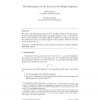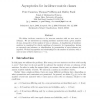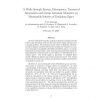22 search results - page 1 / 5 » Discrepancy of Matrices of Zeros and Ones |
COMBINATORICS
1999
13 years 10 months ago
1999
Let m and n be positive integers, and let R = (r1, . . . , rm) and S = (s1, . . . , sn) be non-negative integral vectors. Let A(R, S) be the set of all m
DM
2010
13 years 11 months ago
2010
We answer the following question of R. L. Graham: What is the discrepancy of the lexicographically-least binary de Bruijn sequence? Here, "discrepancy" refers to the max...
COMBINATORICS
2006
13 years 11 months ago
2006
We define incidence matrices to be zero-one matrices with no zero rows or columns. We are interested in counting incidence matrices with a given number of ones, irrespective of th...
NA
2008
13 years 10 months ago
2008
(A) The celebrated Gaussian quadrature formula on finite intervals tells us that the Gauss nodes are the zeros of the unique solution of an extremal problem. We announce recent re...
CRYPTO
2009
Springer
14 years 5 months ago
2009
Springer
We suggest practical sub-linear size zero-knowledge arguments for statements involving linear algebra. Given commitments to matrices over a finite field, we give a sub-linear siz...



